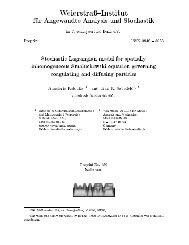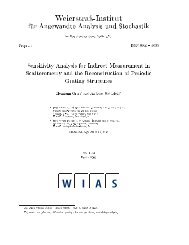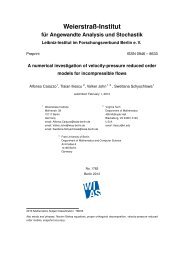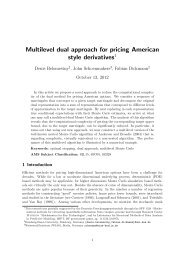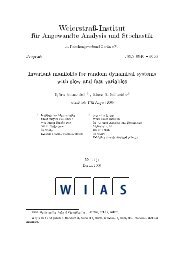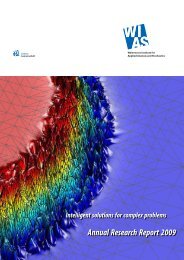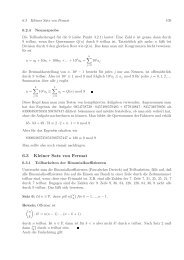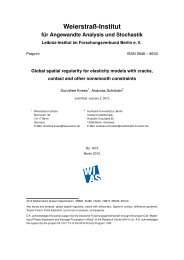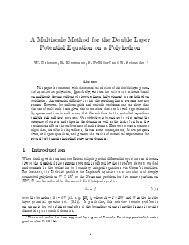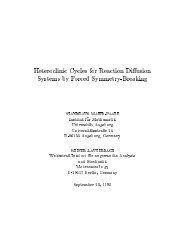PDF (5143 kByte) - WIAS
PDF (5143 kByte) - WIAS
PDF (5143 kByte) - WIAS
Create successful ePaper yourself
Turn your PDF publications into a flip-book with our unique Google optimized e-Paper software.
For G := diag{1, 1, 1, 1, 1, 1} it holds<br />
6<br />
why<br />
gR = inf{<br />
1<br />
0<br />
i=1<br />
|ϕi(s)| 2 = Gϕ(s)( ˙ϕ(s), ˙ϕ(s)),<br />
Gϕ(s)( ˙ϕ(s), ˙ϕ(s))ds<br />
1/2<br />
ϕ(0) = e, ϕ(1) = g and ˙ϕ(s) =<br />
with ϕ ∈ C 1 ([0, 1] , SE(3)) , where<br />
6<br />
i=1<br />
ϕi(s)Ai|ϕ(s)},<br />
Hence, the Riemannian 2-norm is left-invariant and well-defined on the space R3 ⋊ S2 . The<br />
same holds true for .R,κ with G := diag{1, 1, 1, κ2 , κ2 , κ2 } yielding the identity<br />
3<br />
|ϕi(s)| 2 6<br />
+<br />
i=1<br />
i=4<br />
κ 2 |ϕi(s)| 2 = Gϕ(s)( ˙ϕ(s), ˙ϕ(s)).<br />
Next, let us consider the non-adaptive estimator of POAS, i.e. Eq. (2) with Kst(s (k)<br />
g1g2/λ) ≡ 1.<br />
This corresponds to a (discrete) convolution on R 3 ⋊ S 2 , see Duits and Franken [2011, Section<br />
3] for a definition, with convolution kernel Ψ(g) := Kloc((v, Ru)R,κ(u,k)/h(u, k))/N (k)<br />
g ,<br />
g = (v, u) ∈ R 3 ⋊ S 2 , and k = 0, ..., k ∗ fixed. Note, that the bandwidths {h(u, k)}k do not<br />
use the embedding of R 3 ⋊ S 2 into SE(3) and that the proportionality parameters {κ(u, k)}k<br />
depend on the gradient u only via the bandwidths. Therefore, we only show left-invariance for<br />
the bandwidths. The bandwidths are determined by solving the following equation w.r.t. h(u1, k)<br />
for each iteration step k and g1 ∈ R 3 ⋊ S 2 , see Section 2.4.<br />
<br />
g2∈R 3 ⋊S 2<br />
( ¯w (k)<br />
g1g2 )2 · ( <br />
g2∈R 3 ⋊S 2<br />
¯w (k)<br />
g1g2 )−2 ! = 1.25 k · <br />
g2∈R 3 ⋊S 2<br />
( ¯w (0)<br />
g1g2 )2 · ( <br />
g2∈R 3 ⋊S 2<br />
¯w (0)<br />
g1g2 )−2 ,<br />
where ¯w (k)<br />
g1g2 denote the non-adaptive weights depending on h(u1, k). We observe that the<br />
bandwidths h(u1, k) depend only on the norm .R,κ(u1,k) with k = 0, ..., k ∗ and on the fixed<br />
values h(u1, 0) = 1 and κ0. Thus, we get the left-invariance of {h(u, k)}k and {κ(u, k)}k. A<br />
convolution on R 3 ⋊S 2 is left-invariant and well-defined iff the convolution kernel is left-invariant<br />
and well-defined. Here, the convolution kernel Ψ depends directly on the left-invariant and welldefined<br />
term .R,κ(u,k)/h(u, k) yielding the desired properties of the non-adaptive estimator.<br />
Finally, we look at the statistical penalty s (k)<br />
g1g2. It is based on the estimates ˆ S (k−1)<br />
g1 and ˆ S (k−1)<br />
g2<br />
from the previous iteration step starting for k = 0 with the non-adaptive and hence left-invariant<br />
and well-defined estimate ˆ S (0)<br />
g1 = <br />
g2 w(0) g1g2Sg2/N (0)<br />
g1 . Hence, it follows by induction that (2)<br />
remains left-invariant and well-defined when using the adaptive weights instead of the nonadaptive<br />
ones.<br />
19




